Environmental Activities at Terminals and Warehouses
Making Use of Advancements to Reduce CO2 Emissions at Domestic Terminals
We set a target of achieving carbon neutrality by 2040 and aim to realize decarbonization at Japan's domestic ports.
- More Information:
(1) Installation of Hybrid-cargo-handling equipment*1
(Tokyo Container Terminal, Kobe Container Terminal)
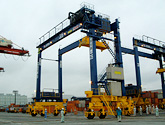
NYK is in the process of introducing hybrid-cargo-handling equipment at two ports in Japan, a first at both these locations. At Tokyo's Ohi container terminal, the new equipment is 90 percent complete. And at the port of Kobe's Rokko Terminal, the replacement is 70 percent complete.
- *1Hybrid-cargo-handling equipment
CO2 emissions can be reduced by 40% by utilizing energy produced and stored when rolling down the crane.
(2) Installing Solar Cells at Tokyo Container Terminal
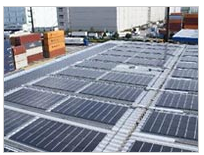
Together with group company NYK Trading Corporation, NYK has installed CIS solar cells*2 at the NYK container terminal in the Port of Tokyo's Ohi Terminal. Approximately 1,600 of these solar panels have been installed on the terminal gate rooftop. The annual generating capacity is about 165,500 kWh, about 10 percent of the electric power consumed annually at the administration building.
The environmental value of the electricity generated by this facility is to be shifted to a third party utilizing the green power certification system.
- *2CIS solar cells
Copper, Indium, Selenium, or CIS, are the major components of CIS solar cells, which have been drawing attention as next-generation solar cells because they do not contain silicon, which is in short supply due to excessive demand. The CIS solar cell belongs to the class with the highest photoelectric conversion efficiency among thin-film-type solar cells. In particular, due to the excellent absorption of sunlight with a black element, the CIS solar cell is superior to the crystalline silicon solar cell that has a bluish element, which reflects a blue light.
- More Information:
(3) New Revolutionary Container Hanger Featuring Solar Cells
NYK, JFE Engineering Corporation, and the Tokyo Port Terminal Corporation have built an innovative, state-of-the-art container hanger at the Ohi Container Terminal's No.6 berth.
This new hanger began operations in April 2011 and improves yard usage through efficient operations. And solar panels on the roof make the terminal much more environment friendly.
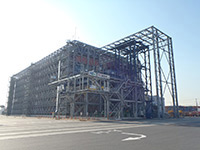
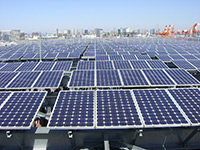
The terminal also features the following advancements:
- Fuel additives*3 are used to improve fuel efficiency and reduce soot and, thus reducing air pollution.
- Older trucks have been replaced with ones that emit less pollution.
- Eco-driving training has been provided to truck drivers.
- Inner packages are used for malt transportation, and waste generated in container yards is recycled.
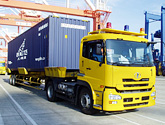
- *3Fuel additive
Factory trials indicate that fuel additives reduce particulate matter by about 25percent and CO2 by about 2percent.
Making Use of Advancements to Reduce CO2 Emissions in Los Angeles
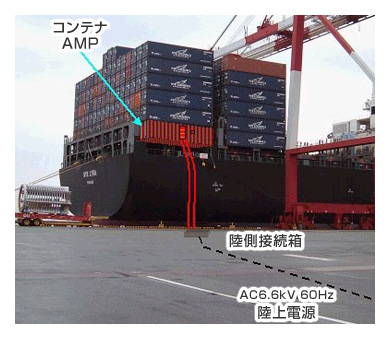
Yusen Terminals Inc. (YTI) in Los Angeles has an on-site solar project that generates about 11,800 kWh of electricity a year from only 96 panels installed in collaboration with NYK parent company NYK Trading; company employees also use electric cars to get around the terminals. Both of these measures have led to a reduction of CO2 emissions and thus aided the City of Los Angeles's antipollution measures. The company also makes use of a power factor correction to efficiently deliver power. In addition, YTI has installed shoreside connection boxes at the terminals to allow moored vessels to plug in to shoreside electrical power as opposed to running on diesel power while at berth.
- More Information:

